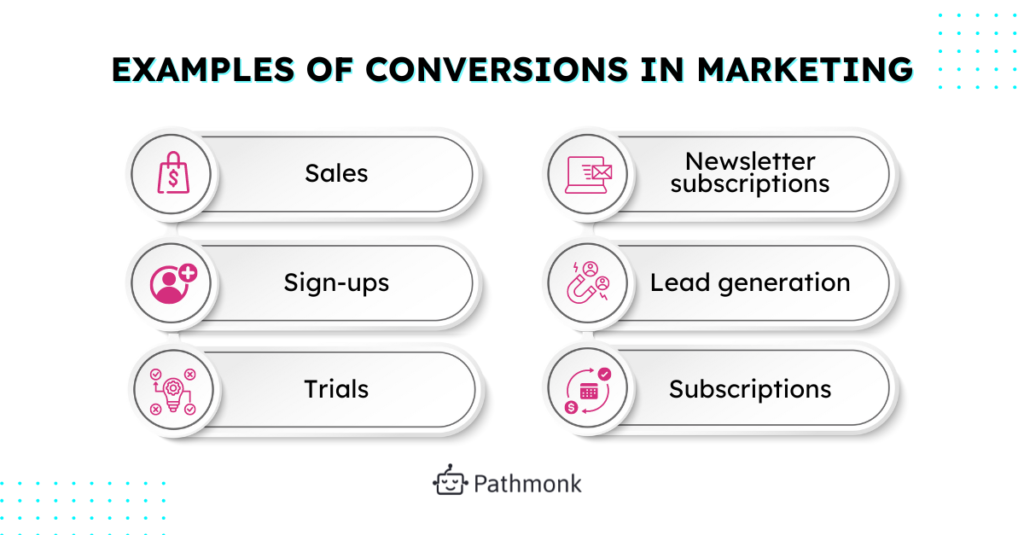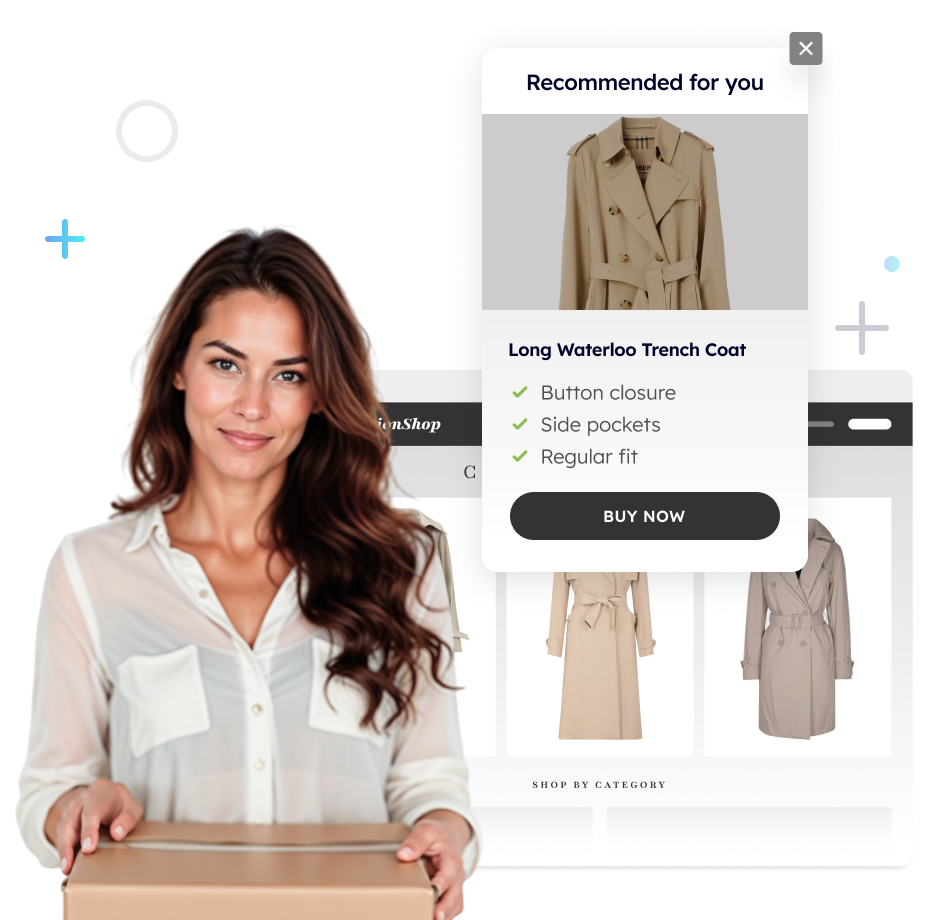
Whether it’s creating an engaging landing page, fine-tuning SEO, or generating social media content that gets clicks, all marketing activities boil down to one thing—conversions.
It’s the core of any successful marketing strategy. And there’s no one better than us to approach this subject: we believe so much in the power of conversions that we’ve built an entire software around it!
But let’s not pretend that every single marketing campaign has “convert now” written all over it. Brand awareness campaigns, social media engagement efforts, and reputation-building projects are all critical, too. They’re about getting your name out there, making sure people know who you are and what you stand for.
But let’s be real—none of those efforts exist in a vacuum. At the end of the day, even those brand-focused strategies are designed with conversions in mind, whether they’re meant to happen next week or next quarter.
Why? Because a successful conversion isn’t just about an immediate sale—it’s about building a relationship with your audience. From the first impression to the final decision, everything we do in marketing leads customers down a path. And that path? You guessed it: it ends in conversion. So, what exactly is a conversion in marketing, and why does it matter so much? Let’s break it down.
Table of Contents
The Concept of Conversion in Marketing
In the simplest terms, a conversion in marketing occurs when a user takes a desired action on your website or through one of your marketing channels. This action can be anything from making a purchase to signing up for a newsletter or downloading a free resource. We’ll discuss different types of conversion in the next section, so hang in there!
In other words, conversion is when a visitor transitions from passive interest to active engagement. The reason it’s called a “conversion” is that it represents the moment when a prospect “converts” into a lead, a subscriber, or even a paying customer, depending on your goals.
Conversions are crucial for the sustainable growth of any business because they reflect the effectiveness of your marketing efforts. High traffic and engagement are great, but if those visitors aren’t taking the actions that contribute to your company’s growth, then the marketing campaigns are not delivering real value.
Conversions are what turn marketing efforts into tangible results. They measure the impact of your marketing and are directly tied to revenue generation. Without tracking conversions, companies risk investing time and money into strategies that don’t contribute to growth.
We’re living in a data-driven era where every interaction can be measured, analyzed, and optimized. The importance of conversions has skyrocketed in this environment because companies can now track every touchpoint in a customer’s journey. This data gives marketing teams the ability to fine-tune their strategies, focusing on what works and eliminating what doesn’t.
Conversions provide clear, measurable proof of success, making them essential for both immediate wins and long-term, sustainable growth. In a world where every action is trackable, conversions have become the compass that guides marketing strategies toward real results.
What Are the Different Types of Conversion in Marketing?
Conversions come in many forms, depending on the goals of your marketing strategy. A conversion isn’t always about making an immediate sale—it’s about moving prospects one step closer to becoming loyal customers.
The specific type of conversion you’re tracking will depend on the purpose of the marketing action. Here are some of the most common types of conversions businesses focus on:
- Sales: This is the ultimate conversion goal for any business that sells any physical or cloud-based products. When a customer completes a purchase, it’s considered a conversion. Every marketing action, from product pages to ad campaigns, is geared toward driving sales conversions.
- Sign-ups: For companies offering services, getting users to sign up for an account or register for a service is often the key conversion goal. This could include signing up for a trial, membership, or event registration. The aim is to move users closer to engaging with your product.
- Trials: In the SaaS world, free trials or demo sign-ups are highly valuable conversions. They mark the first step toward getting a customer to experience your software firsthand. The more trials you secure, the better your chances of converting users into paying customers later on.
- Newsletter subscriptions: Gaining subscribers to a newsletter is a common conversion type, especially for businesses that focus on content marketing. This provides a direct line of communication, allowing you to nurture leads over time by sharing valuable information.
- Lead generation (forms and submissions): Collecting leads via form submissions is a conversion aimed at gathering contact information for future marketing efforts. Whether it’s a request for a consultation, quote, or more information, lead generation helps to build a potential customer base that can be followed up with later.
Subscriptions: For businesses that offer recurring services or content (like streaming platforms, membership sites, or subscription boxes), getting a user to subscribe is a key conversion metric. Subscription models often rely heavily on building long-term customer relationships, so each subscription counts as a win for the business.

The beauty of conversions is their adaptability to each business’s unique goals. A conversion in one company might look completely different from another, depending on the marketing objectives.
For example, a company focused on building a community might prioritize email sign-ups, while an online retailer’s focus will be on product sales. Understanding what defines a conversion in your specific marketing context is key to driving meaningful outcomes and growth. By tailoring the definition of “conversion” to match your purpose, you can measure success in a way that aligns with your broader business goals.
How to Calculate Your Conversions
Calculating your conversions is fairly straightforward, but it’s important to understand what exactly you’re measuring. The basic formula for calculating conversions is:
Conversion Rate = (Number of Conversions / Number of Total Visitors) x 100
This formula gives you a percentage, which represents how many of your visitors are completing the desired action, whether that’s making a purchase, signing up for a newsletter, or filling out a form. The higher the conversion rate, the more effective your marketing efforts are at driving engagement.
Practical Example 1: Paid Campaign Conversions
Let’s say you’re running a paid Google Ads campaign, and the goal is to get people to sign up for a free trial of your product. If 1,000 people clicked on your ad and 50 of them signed up for the trial, your conversion rate would be calculated as follows:
Conversion Rate = (50 / 1,000) x 100 = 5%
This means 5% of the people who visited your site from the ad completed the sign-up process, which is considered the conversion. You can use this metric to evaluate the performance of your ad and optimize it further for better results.
Practical Example 2: Landing Page Conversions
Now, imagine you’ve created a dedicated landing page for an ebook download. The page gets 500 visitors, and 100 of them fill out the form to download the ebook. In this case, your conversion rate would be:
Conversion Rate = (100 / 500) x 100 = 20%
A 20% conversion rate on a landing page is often seen as a strong performance. But the beauty of tracking conversion rates is that you can test and adjust various elements on the page—like the copy, images, or call-to-action buttons—to improve that percentage even further.
Practical Example 3: E-commerce Sales Conversion
For an e-commerce business, sales conversions are critical. Suppose your online store receives 10,000 visitors in a month, and 200 of them make a purchase. Your sales conversion rate would be:
Conversion Rate = (200 / 10,000) x 100 = 2%
A 2% sales conversion rate is fairly standard in many industries, but like any other conversion type, it can vary depending on factors such as industry, target audience, and the marketing channel used.
Increase e-commerce sales with personalized experiences
Turn your e-commerce visitors into loyal customers with AI-powered personalization.

Why Conversion Calculations Matter
Calculating your conversions and conversion rates helps you understand the effectiveness of your marketing campaigns. More importantly, it allows you to spot areas for improvement. If a particular campaign or page is underperforming, a low conversion rate will highlight the need for optimization. Conversely, high-performing conversions can serve as a benchmark or model for future marketing efforts.
By continually measuring and optimizing conversions, you ensure that your marketing efforts are not just driving traffic but actually moving people toward the actions that matter most to your business’s growth. In the data-driven world we live in, tracking conversion metrics is the foundation of effective marketing strategies.
What Are The Best-Practices for Conversion in Marketing?
By following some best practices you can create a more streamlined, effective conversion strategy across different marketing channels. Here are some of them:
1. Build a Strong Brand Presence
A consistent and recognizable brand builds trust, which is crucial for conversions. Ensure your messaging, visuals, and tone are aligned across all marketing channels. When users feel confident in your brand, they are more likely to take action and convert.
2. Leverage Marketing Automation
Automation can enhance your conversion efforts by delivering personalized content at the right time. Tools like automated email campaigns and chatbots can engage users and guide them through the buyer’s journey, increasing the likelihood of conversion.
3. Create Targeted Campaigns with Segmentation
Segmenting your audience allows you to deliver more relevant and personalized campaigns. Tailored messaging based on user behavior or demographics increases engagement and improves the chances of conversion by speaking directly to each group’s needs.
4. Continuously Measure and Optimize
Regularly track and analyze your conversion metrics to identify areas for improvement. Use tools like Pathmonk to gather insights, then make data-driven adjustments to optimize your campaigns for better conversion rates.
Instruments to Increase Conversions in Marketing
On top of the best practices, there are several tools marketers can apply to understand their audience and improve their conversion in marketing. Each of these has its own strengths, but also some limitations to keep in mind.
1. Heatmaps
Heatmaps visually represent where users are clicking, scrolling, or spending the most time on your website. They help identify which elements are attracting attention and which are being ignored. However, while heatmaps show user behavior, they don’t explain why users behave that way, limiting their ability to provide actionable insights.
2. User Feedback
Gathering direct feedback from users through surveys, polls, or usability testing can provide valuable insights into what is working and what’s not. The downside is that feedback can be subjective, often reflecting individual opinions rather than the overall user experience, making it difficult to interpret at scale.
3. Mobile Optimization
With more users browsing on mobile devices, optimizing your site for mobile is crucial for improving conversions. Ensuring fast load times and a user-friendly interface is key.
4. A/B Testing
A/B testing compares two versions of a webpage or element (like a headline or CTA) to see which performs better. It’s an effective way to make data-driven decisions. The downside? Creating A/B tests can be time-consuming and testing multiple elements at once can also complicate interpretation.
AI-powered Conversion Rate Optimization
In your studies about conversion in marketing, you will very likely come across an important concept: Conversion Rate Optimization. CRO is the practice of increasing the percentage of visitors to your website who take a desired action. This is usually achieved by refining the user experience, removing the friction and guiding users toward conversion.
Many instruments that can help you optimize your conversions may take precious time from your marketing team. Luckily, Pathmonk’s all-in-one CRO solution does everything automatically, with little to no effort from your team!
Through advanced AI, Pathmonk personalizes the user experience in real time, boosting your chances of converting visitors into leads. By analyzing intricate behavioral data, Pathmonk can identify which visitors are most likely to convert. These high-potential users are then presented with personalized micro-experiences that speed up their journey to conversion.
On top of tailoring the on-page content, Pathmonk’s AI also powers adaptive lead capture forms. These forms dynamically adjust based on user behavior, making it easier to engage and convert visitors into leads. This level of personalization, driven by AI and behavioral insights, allows businesses to maximize conversions, turning more visitors into customers without the need for a large marketing budget. Ready to see it in action? Try our interactive demo today!
Increase +180%
leads
demos
sales
bookings
from your website with AI
Get more conversions from your existing website traffic delivering personalized experiences.






